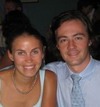Tim Fater

It was winter break of my junior year at Fairfield University in December of 2003. In a month, I would be leaving for a semester abroad in Australia. Life was good. One day I happened to notice a funky looking freckle on the top of my right forearm. I showed it to my mom, who is a nurse, and we both decided that while it probably was not a big deal, it would be a good idea to get it checked out before I left for Australia. I was informed via a phone call with the results of the biopsy; the tissue removed was benign.
Fast-forward a year and half to June 2005. I had just graduated from Fairfield in May and was on the customary European backpacking trip. While sitting on the train, I noticed the hints of a subtle re-growth emerging from the scar on my forearm where that initial excision had taken place. When I got back to the States, I immediately scheduled an appointment with a dermatologist to have the growth examined.
I remember sitting in the doctor’s office with my parents. Over the last few days there had been a lot of talk between the various doctors who had been involved in my case and myself and my parents. I could tell by the way this was being treated that this was something serious, although no one wanted to admit it until we knew for certain. My doctor came in and explained the bad news. It turns out that both the original freckle removed in 2003 and the re-growth were both malignant melanoma.
I remember having mixed feelings as I sat there: I was shocked that something like this could happen to me, at my age; scared of what was to come; and confused as to how my original diagnosis from 2003 was incorrect.
Upon the melanoma diagnosis, my family and I immediately had my care transferred from the doctors in my hometown to the Dana Farber Cancer Institute in Boston, Massachusetts. I remember one of my first meetings with the dermatologist very clearly. I would like to preface this by saying that the doctors and staff at Dana Farber are incredible people. They are also realists; they can not afford to nor do they think it is right to sugar-coat their patients’ situations. That being said, the dermatologist that day informed me that a patient in my situation, with the recurrence, depth of the disease and the amount of time that had elapsed, had a 5 year survival rate of 50%.
That was obviously tough news. It was around that time that I committed myself to a positive outlook; I taught myself to disregard such negative news which I knew could be lurking around the corner at any time. At that point everything was one day at a time.
I ended up having a fairly major surgery and skin graft on my arm to ensure wide margins, both a sentinel and radical lymph node dissection on the nodes in my right armpit and underwent the year-long interferon treatment. That sounds tough when put all together like that. But taken one day at a time it wasn’t so bad.
Since then, I’ve stayed vigilant through countless doctor’s appointments, skin checks, scans and follow-ups at Dana Farber. Luckily, there has been no sign of the disease since the removal of the lymph nodes in the Fall of 2005.
As I look back on the whole experience now, I can credit the origin of the disease pretty certainly on my sun exposure during my childhood and teenage years. Growing up in the coastal city of Newport, Rhode Island – I was always outside. Whether it was playing sports, sailing, surfing, golfing or working at an outdoor bar on the beach. I specifically remember a number of bad sunburns. It was an annual thing – part of the summertime routine. I did not use sunscreen nearly as much as I should have; nor was I ever particularly good at listening to most of the repetitive warnings and sun smart rules that are often lectured. This might be the most frustrating part of the whole experience – the fact that skin cancer is, for the most part, very preventable.
All of my friends and family are well aware of my experience with melanoma. I have been very open throughout the whole ordeal to anyone who has had questions, comments or concerns. As such, many of the people close to me have used my experience as a wake up call for them to improve their sun smarts. I try to lead by example. This openness lead me to seek opportunities to share my story and offer a hand, where I could. I am currently involved with the IMPACT Melanoma’s Billy’s Buddies program, a mentoring program for melanoma patients and survivors as well as IMPACT Melanoma’s No-Tanning program for high school students called Your Skin Is In.

